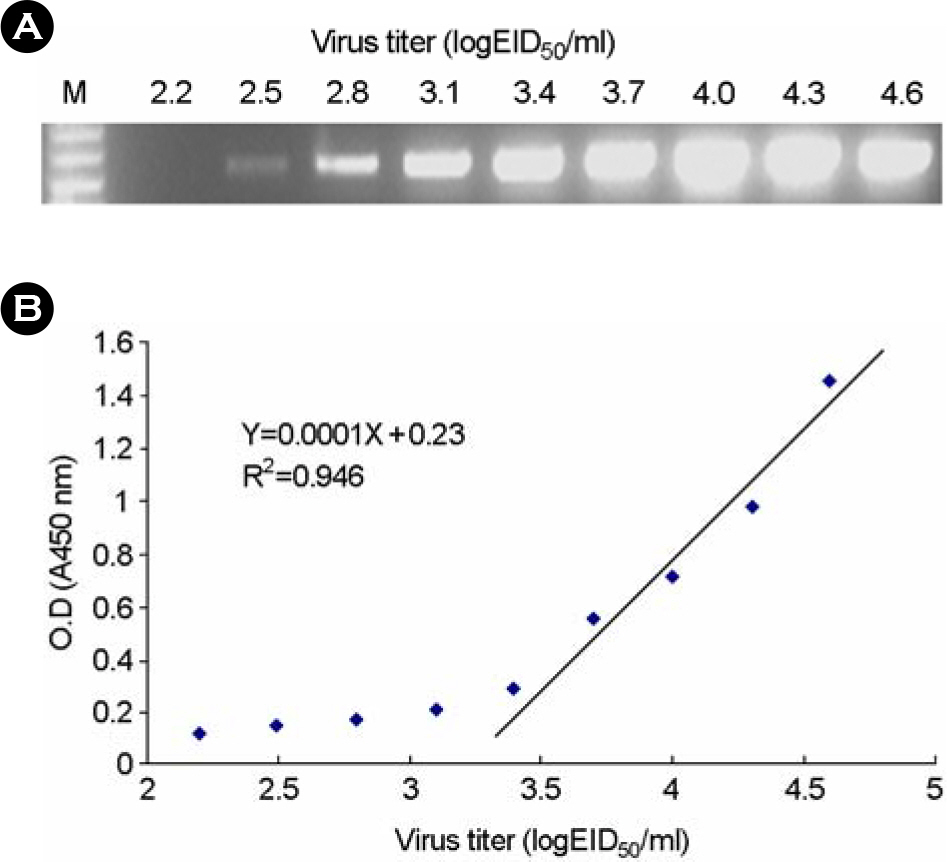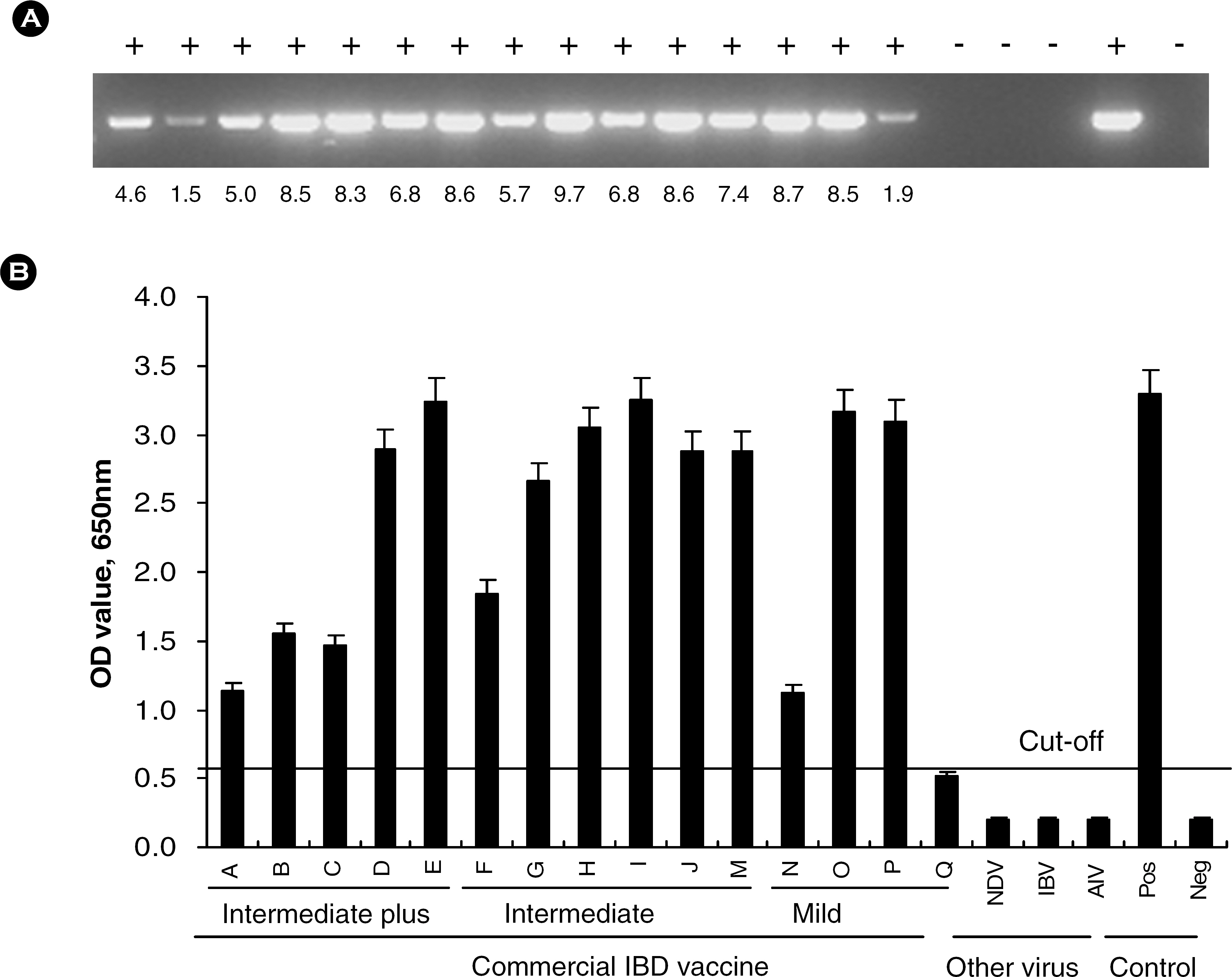J Bacteriol Virol.
2008 Sep;38(3):139-147. 10.4167/jbv.2008.38.3.139.
Detection of Infectious Bursal Disease Virus by Double Antibody Sandwich ELISA
- Affiliations
-
- 1National Veterinary Research Institute, National Veterinary Research and Quarantine ServiceAnyang, Gyeonggi, Korea. choiks@nvrqs.go.kr
- 2JenoBiotech Inc, Chuncheon, Gangwon, Korea.
- KMID: 1483972
- DOI: http://doi.org/10.4167/jbv.2008.38.3.139
Abstract
- Infectious bursal disease virus (IBDV) is responsible for a highly contagious disease of poultry causing severe immunosuppression in chickens. A double antibody sandwich ELISA (DAS-ELISA) was developed to detect IBDV from clinical samples. Two kinds of anti-IBDV antibodies, monoclonal antibody R63 and chicken anti-IBDV sera, were used for DAS-ELISA. Detection limit of IBDV by DAS-ELISA was approximately 10(2.7) EID(50)/ml. The DAS-ELISA detected IBDV from most (13/14) of vaccine products including mild, intermediate and intermediate-plus types. The DAS-ELISA also detected IBDV from all (19/19) of field Korean isolates including very virulent and intermediate-plus phenotypes. Our results indicate that the DAS-ELISA would provide useful diagnostic tool to detect IBDV from clinical samples as well as rapid quantitative detection of IBDV.
Keyword
MeSH Terms
Figure
Reference
-
1). 이영옥, 김순재, 최정옥, 전무상, 박근식: 국내종계의 infectious bursal disease virus 의 감염상황 및 분리주의 생물학적 특성. 농사시험보고서 (축산, 가축위생편). 23:136–142. 1981.2). Abdel-Alim GA., Saif YM. Pathogenicity of cell culture-derived and bursa-derived infectious bursal disease viruses in specific-pathogen-free chickens. Avian Dis. 45:844–852. 2001.
Article3). Böttcher B., Kiselev NA., Stel'Mashchuk VY., Perevozchikova NA., Borisov AV., Crowther RA. Three-dimensional structure of infectious bursal disease virus determined by electron cryomicroscopy. J Virol. 71:325–330. 1997.
Article4). Brandt M., Yao K., Liu M., Heckert RA., Vakharia VN. Molecular determinants of virulence, cell tropism, and pathogenic phenotype of infectious bursal disease virus. J Virol. 75:11974–11982. 2001.
Article5). Chettle N., Stuart JC., Wyeth PJ. Outbreak of virulent infectious bursal disease in East Anglia. Vet Rec. 125:271–272. 1989.
Article6). Delmas B., Kibenge FSB., Leong JC., Mundt E., Vakharia VN., Wu JL. Birnaviridae. pp. p. 561–569. In. Virus Taxonomy. Eighth report of the International Committee on Taxonomy of Viruses. Fauquet CM, Mayo MA, Maniloff J, Desselberger U, Ball LA, editors. (Ed),. Academic Press;London: 2004.7). Eterradossi N., Arnauld C., Toquin D., Rivallan G. Critical amino acid changes in VP2 variable domain are associated with typical and atypical antigenicity in very virulent infectious bursal disease viruses. Arch Virol. 143:1627–1636. 1998.
Article8). Fahey KJ., Erny K., Crooks J. A conformational immunogen on VP-2 of infectious bursal disease virus that induces virus-neutralizing antibodies that passively protect chickens. J Gen Virol. 70:1473–1481. 1989.
Article9). Fahey KJ., McWaters P., Brown MA., Erny K., Murphy VJ., Hewish DR. Virus-neutralizing and passively protective monoclonal antibodies to infectious bursal disease virus of chickens. Avian Dis. 35:365–373. 1991.
Article10). Hassan MK., Saif YM., Shawky S. Comparison between antigen-capture ELISA and conventional methods used for titration of infectious bursal disease virus. Avian Dis. 40:562–566. 1996.
Article11). Ismail NM., Saif YM., Moorhead PD. Lack of pathogenicity of five serotype 2 infectious bursal disease viruses in chickens. Avian Dis. 32:757–759. 1988.
Article12). Jackwood DJ., Sommer-Wagner S. Genetic characteristics of infectious bursal disease viruses from four continents. Virology. 365:369–375. 2007.
Article13). Kim TK., Yeo SG. Cloning and nucleotide analysis of segment A gene of infectious bursal disease virus detected in Korea. Virus Genes. 26:97–106. 2003.14). Kwon HM., Kim DK., Hahn TW., Han JH., Jackwood DJ. Sequence of precursor polyprotein gene (segment A) of infectious bursal disease viruses isolated in Korea. Avian Dis. 44:691–696. 2000.
Article15). Kwon YK., Mo IP., Seong HW., Kang MI., Koh HB., Lee JG., Yang CK. Studies on the Pathogenicity of infectious bursal disease virus (SH/92) isolated in Korea. RDA J Agri Sci. 37:637–647. 1995.16). McFerran JB., McNulty MS., McKillop ER., Conner TJ., McCracken RM., Collins DS., Allan GM. Isolation and serological studies with infectious bursal diseases from fowl, turkey and duck: demonstration of a second serotype. Avian Pathol. 9:395–404. 1980.17). Rodriguez-Chavez IR., Rosenberger JK., Cloud SS., Pope CR. Characterization of the antigenic, immunogenic, and pathogenic variation of infectious bursal disease virus due to propagation in different host systems (bursa, embryo, and cell culture), III: pathogenicity. Avian Pathol. 31:485–492. 2002.
Article18). Sapats SI., Ignjatovic J. Antigenic and sequence heterogenicity of infectious bursal disease virus strains isolated in Australia. Arch Virol. 145:773–785. 2000.19). Snyder DB., Lana DP., Cho BR., Marquardt WW. Group and strain-specific neutralization sites of infectious bursal disease virus definedf with monoclonal antibodies. Avian Dis. 32:527–534. 1988.20). Snyder DB., Lana DP., Savage PK., Yancey FS., Mengel SA., Marquardt WW. Differentiation of infectious bursal disease viruses directly from infected tissues with neutralizing monoclonal antibodies: evidence of a major antigenic shift in recent field isolates. Avian Dis. 32:535–539. 1988.
Article21). Snyder DB., Vakharia VN., Savage PK. Naturally occurring neutralizing monoclonal antibody escape variants define the epidemiology of infectious bursal disease virus in the United States. Arch Virol. 127:89–101. 1992.22). Spies U., Müller H., Becht H. Properties of RNA polymerase activity associated with infectious bursal disease virus and characterization of its reaction products. Virus Res. 8:127–140. 1987.
Article23). van den Berg TP. Acute infectious bursal disease in poultry: a review. Avian Pathol. 29:175–194. 2000.24). van den Berg TP., Morales D., Eterradossi N., Rivallan G., Toquin D., Raue R., Zierenberg K., Zhang MF., Zhu YP., Wang CQ., Zheng HJ., Wang X., Chen GC., Lim BL., Muller H. Assessment of genetic, antigenic and pathotypic criteria for the characterization of IBDV strains. Avian Pathol. 33:470–476. 2004.
Article25). Winterfield RW., Fadly AM., Bickford A. Infectivity and distribution of infectious bursal disease virus in the chicken: persistence of the virus and lesions. Avian Dis. 16:622–632. 1972.
Article26). Zhang A., Jin M., Liu F., Guo X., Hu Q., Han L., Tan Y., Chen H. Development and evaluation of a DAS-ELISA for rapid detection of avian influenza viruses. Avian Dis. 50:325–330. 2006.
Article
- Full Text Links
- Actions
-
Cited
- CITED
-
- Close
- Share
- Similar articles
-
- Production of monoclona antibody to infectious bursal disease virus as a diagnostic methods
- Detection of Antibodies to Infectious Bursal Disease Virus (IBDV) by Agar Gel Immunodiffusion using Recombinant VP2 Protein
- Efficacy of VP2 protein expressed in E. coli for protection against highly virulent infectious bursal disease virus
- Serotype- and serogroup-specific detection of African horsesickness virus using phage displayed chicken scFvs for indirect double antibody sandwich ELISAs
- Sequence analysis of segment A gene of a very virulent infectious bursal disease virus recently isolated in Korea




